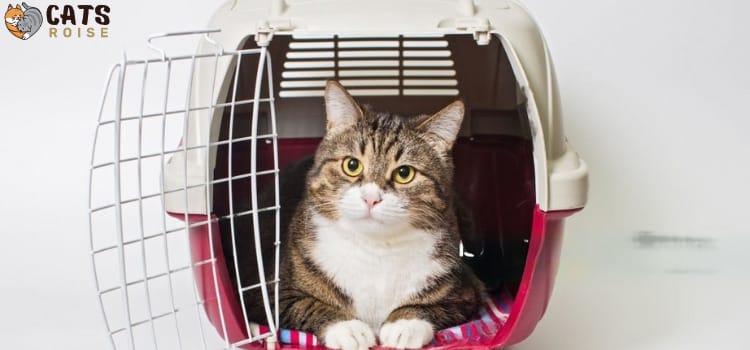Curiosity may have killed the cat, but what about being confined in a carrier? How long is too long for our feline friends to be cooped up inside this seemingly small space? Whether planning a trip to the vet or embarking on an adventure, understanding the limits and ensuring your cat’s comfort is essential.
In today’s blog post, we’ll unveil how long your whiskered companion can safely stay in a carrier without compromising their well-being. So hold onto your seat (or page) as we unravel this mystery and equip you with all the knowledge you need to ensure perfect travels!”
What Exactly Is A Carrier?

A carrier is a portable container designed specifically for transporting pets. It typically has a handle for easy carrying and can come in different materials such as plastic, fabric, or wire mesh.
Some have hard shells made of plastic or metal, while others have soft sides made of fabric or mesh. The type of carrier you choose will depend on your needs and preferences.
Cats and carriers go hand in hand, whether for a trip to the vet or a journey to a new home. For most cat owners, using a page is essential to owning a feline friend.
However, have you ever wondered how long your cat can safely stay in a carrier? In this section, we will introduce you to the topic of cats and pages and provide important information that every cat owner should know.
Why Do Cats Need Carriers?
Cats are naturally curious creatures but have their own set of boundaries. While some may enjoy car rides or exploring outside, others may feel anxious or scared when taken out of their comfort zone.
Placing them in a secure carrier helps keep them safe and prevents them from running away or getting injured while traveling.
Carriers typically have a door or opening that allows you to place your cat inside and secure them in place during transportation. Many also have handles or straps for easy carrying.
Understanding The Purpose Of A Carrier For Cats:
A carrier is essential for any cat owner, especially when transporting your feline friend from one place to another. However, many people may need help understanding the purpose and importance of using a carrier for their cats.
In this section, we will delve into why carriers are necessary for cats and how they serve various purposes in ensuring the safety and well-being of our furry companions.
1. Safety And Security:
The primary purpose of a carrier is to provide a safe and secure mode of transportation for your cat.
Unlike dogs, cats are not typically fond of being leashed or harnessed, making it difficult to control them outside. In situations like vet visits or travel, where you must take your cat out of the house, a carrier ensures they remain confined and protected from danger.
Furthermore, carriers also prevent your cat from escaping or running away in unfamiliar environments. This is especially important if you are traveling with your cat by plane or car, as they can easily get spooked by new surroundings and try to escape.
2. Comfortable Space:
Apart from safety, carriers also offer a comfortable space for cats during transportation.
Most pages are designed with ample room for your cat to move around and stretch its legs comfortably while still feeling snug and secure inside. This helps reduce stress levels in cats who may feel anxious or overwhelmed during travel.
Factors That Influence How long A Cat Can Stay In A Carrier:
Several factors can influence how long a cat can comfortably stay in a carrier.These factors can vary from individual cats to different types of carriers.
Understanding these factors is important for ensuring the well-being and comfort of your furry friend during travel or other situations that require them to be on a page.
1. Size And Type Of Carrier:
The size and type of carrier you choose for your cat can greatly impact their comfort level and ability to stay inside for an extended period.
The general rule is that the page should be big enough for your cat to stand up, turn around, and lie down comfortably.
A cramped space can cause stress and discomfort, leading to a shorter duration a cat can stay in it.
Additionally, the type of carrier also matters as some may have better ventilation or provide more hiding spots, making it easier for the cat to relax.
2. Familiarity With The Carrier:
Cats are creatures of habit, and they prefer familiar environments over new ones. If your cat is not used to being in a carrier, they may become anxious or stressed out when placed inside one. It is essential to gradually introduce your feline friend to the page by leaving it open in their living space and providing treats or toys inside so they associate it with positive experiences.
3. Level Of Comfort:
A comfortable carrier can make all the difference in how long a cat can tolerate being inside it. Soft bedding material such as towels or blankets helps create a cozy environment for your pet.
Recommended Duration For Keeping A cat In A Carrier:
The recommended duration for keeping a cat in a carrier may vary depending on the circumstances. Still, generally, it is important to limit the time your feline friend spends on a page.
Cats are naturally curious and active animals, and being confined to a small space for an extended period can cause them stress and discomfort.
In most cases, the maximum time a cat should be kept in a carrier is around 2-3 hours. This time frame allows for short trips such as visits to the veterinarian or travel to a new location.
It is important to note that this time frame should only be used if necessary, and every effort should be made to reduce the duration as much as possible.
If you are traveling with your cat, planning your trip with plenty of breaks is recommended so your furry companion can stretch their legs and relieve themselves if needed. Additionally, ensure the carrier has enough ventilation and comfortable bedding for your cat during longer journeys.
Aim to keep your cat in the carrier for shorter trips around town or quick errands for no more than an hour. This gives them enough time to adjust to their surroundings without causing stress or discomfort.
It’s also essential to consider your cat’s age, health condition, and temperament when determining how long they can be in a carrier.
Kittens or senior cats may need more frequent breaks due to their smaller bladder capacity or limited mobility. Cats with health issues may also have difficulty staying in one position for extended periods of time.
Signs That Your Cat May Need To Be Let Out Of The Carrier Sooner:
Traveling with a cat can be a stressful experience for both the owner and the feline. One of the most common concerns when traveling with a cat is how long they can safely be contained in a carrier. While keeping your cat secure during travel is important, ensuring their safety and well-being is equally important by letting them out of the airline at appropriate intervals.
As a pet owner, you know your cat best and can recognize when they are becoming uncomfortable or distressed.
However, there are some definite signs that your cat may need to be let out of the carrier sooner rather than later. These signs include:
1. Excessive Meowing Or Vocalization:
Cats use meowing to communicate with their owners. If you’re usually quiet kitty starts meowing excessively while inside the carrier, it could indicate that they are feeling anxious or stressed and need to stretch their legs.
2. Pacing Inside The Carrier:
Just like humans, cats also like to move around and explore their surroundings. If you notice your cat pacing back and forth inside the page, it could mean they need more space or exercise outside the confined space.
3. Aggressive Behavior:
Cats may display aggressive behavior if they feel trapped or threatened. This could manifest as hissing, swatting, or biting at anyone who tries to approach or handle them while inside the carrier.
Tips For Making The Carrier Experience More Comfortable For Your Cat:
There are various reasons why your cat may need to be in a carrier, whether for a trip to the vet, traveling, or moving to a new home.
To ensure that your feline friend has a comfortable experience while in their career, here are some tips you can follow:
1. Get The Right Size Carrier:
Choosing a carrier that is the appropriate size for your cat is essential. If it is too small, your cat will feel cramped and uncomfortable.
On the other hand, being too big may cause your cat to slide around during travel, leading to injury. The ideal carrier should be large enough for your cat to stand up comfortably and turn around.
2. Familiarize Your Cat With The Carrier:
Many cats associate carriers with negative experiences like going to the vet or being separated from their owners. Help alleviate this stress by getting them used to the page before any trips.
Leave it open in a quiet area of your home and put some treats or toys inside so they can explore at their own pace.
3. Line The Carrier With Familiar Items:
Another way to make the page more inviting for your cat is by lining it with everyday items such as their favorite blanket or toy. The familiar scent will help them feel more at ease while inside.
Alternatives To Using A Carrier For Transportation Or Confinement:
Sometimes, using a carrier for transportation or confinement is not possible or recommended for your cat. In these situations, it’s important to know what alternatives are available to ensure the safety and well-being of your feline friend.
1. Harness And Leash:
If you need to transport your cat on foot, a harness and leash can be a great alternative to a carrier. It allows them more freedom of movement while still keeping them secure. Choose a saddle that fits properly and is specifically designed for cats.
2. Travel Crate:
A travel crate is another option for longer trips with your cat, such as traveling by car or plane. These crates are larger than traditional carriers and provide more space for your cat to move around and stretch their legs. They also allow for better ventilation, which can help reduce stress levels during travel.
3. Pet Stroller:
A pet stroller can be an excellent alternative to a carrier for shorter trips or outings. This option provides mobility and security, allowing your cat to enjoy some fresh air while being contained in a safe space.
4. Pet Sling Or Backpack:
If you’re looking for hands-free transportation options, consider using a pet sling or backpack designed specifically for cats. These carriers allow you to keep your cat close while still having the use of both hands.
5. Enclosed Playpen:
When it comes to confining your cat safely indoors, an enclosed playpen may be the best alternative to using a crate.
Conclusion: Finding The Balance Between Safety And Comfort For Your Cat
When it comes to traveling with your feline companion, finding the balance between safety and comfort is crucial.
As a cat owner, you want to ensure that your furry friend is safe and secure during the journey, but at the same time, you also want them to be comfortable and stress-free. So how can you achieve both? Let’s dive into some tips on finding the perfect balance between safety and comfort for your cat in a carrier.
Firstly, it is essential to choose the right carrier for your cat. Various types of pages are available in the market, including hard-sided plastic carriers, soft-sided carriers, and even backpack-style carriers.
It is important to consider the size and weight of your cat when selecting a carrier, as it should be spacious enough for them to move around comfortably yet small enough that they do not feel overwhelmed or cramped. Also, ensure the carrier has proper ventilation holes for fresh air circulation.
Once you have chosen a suitable carrier for your cat, getting them accustomed to it before traveling long distances is crucial; start by leaving the page out in their usual living space so they can explore and get comfortable with it at their own pace.
You can also place familiar items, such as their favorite toys or blankets, inside the carrier to create a positive association with it.
Next, gradually introduce short trips using the carrier around town before embarking on longer journeys. This will help your cat become more familiar and comfortable with being in a confined space while moving.




